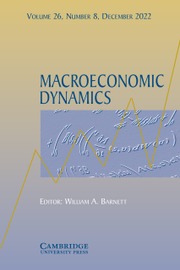No CrossRef data available.
Article contents
Financial complexity, cycles and income inequality
Published online by Cambridge University Press: 15 September 2025
Abstract
We introduce a banking sector and heterogeneous agents in the dynamic overlapping generations model of Matsuyama et al. (2016). Our model captures the benefits and costs of an advanced banking system. While it allocates resources to productive activities, it can also hinder progress if it invests in projects that do not contribute to capital formation, and potentially triggering instabilities due to the emergence of cycles. Our intergenerational dynamic framework enables us to show that income inequality between agents increases during recessions, confirming empirical observations. Moreover, we identify both changes in production factor prices and the reallocation of agents across occupations as driving factors behind the increased inequality.
Information
- Type
- Articles
- Information
- Copyright
- © The Author(s), 2025. Published by Cambridge University Press
Footnotes
Disclaimer: The views expressed in this paper do not necessarily reflect those of the Oesterreichische Nationalbank or the Eurosystem. This paper supersedes an earlier draft circulated under the title “Financial Development, Cycles and Income Inequality in a Model with Good and Bad Projects” (CESifo Working Paper No. 10135, Dec. 2022).

